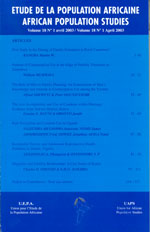
|
African Population Studies
Union for African Population Studies
ISSN: 0850-5780
Vol. 12, No. 2, 1997
|
 Bioline Code: ep97015
Bioline Code: ep97015
Full paper language: French
Document type: Research Article
Document available free of charge
|
|
|
African Population Studies, Vol. 12, No. 2, 1997
| en |
Omoluabi-Siegert, Elizabeth
Abstract
Children's health in Nigéria was studied using simple anthropometric measures (weight, height, brachial perimeter and pace of growth) derived from three surveys, one of which is a multiple round. Nigerian children are born with weights and heights above the international standard. This advantage however, only lasts a few months. As early as the age of six months, an increasing degradation of the nutritional status sets in, characterized by a 'change of birth track' and the trivialisation of anthropometric measurements close to two standard deviations below the international standard. The delay in stature development is more significant than weight growth since, Nigerian children often benefit from a "catch-up" effect of the weight during the dry season after the harvest. The malnutrition risk is particularly greater between the age of one to three years, with a peak at two years of age that often corresponds with the arrival of the next child. The importance of the seasons, particularly the danger of the rainy season for the children's health was confirmed by the study. In the rural areas, the rainy season is a period of crisis during which food shortage and high morbidity are factors that weaken children's health and further expose them to death. "Excess mortality after the age of one year", a characteristic of infant childhood mortality in West Africa could be explained by the deterioration of children's health and the change of birth track highlighted here.
|
| |
| fr |
Une Enquête à Passages Répétés sur la Santé des Enfants au Sud du Nigéria
Omoluabi-Siegert, Elizabeth
Résumé
La santé des enfants du Nigéria a été étudiée grâce à des mesures anthropométriques simples (le poids, la taille, le périmètre brachial et le rythme de croissance) provenant de trois enquêtes dont une à passages répétés. Les enfants nigérians naissent avec un poids et une taille au-dessus du standard international. Cet avantage ne dure que quelques mois. Dès l'âge de six mois une dégradation de plus en plus importante de l'état nutritionnel s'installe caractérisée par un 'changement de couloir de croissance' et la banalisation des mensurations anthropométriques proche de 2 écarts types en dessous du standard international. Le retard de croissance staturale a plus d'ampleur que celui de la croissance pondérale, les enfants nigérians bénéficiant souvent d'un effet de "rattrapage" du poids pendant la saison sèche après la récolte. Le risque de malnutrition est particulièrement important entre l'âge d'un an et trois ans, avec un pic à deux ans, l'âge qui correspond souvent à l'arrivé d'un cadet. L'importance des saisons, notamment le danger de la saison des pluies pour la santé des enfants a été confirmée par l'étude. En milieu rural la saison des pluies est une période de crise où pénurie alimentaire et forte morbidité concourent à fragiliser la santé des enfants et à les tirer vers la mort. La "surmortalité après l'âge d'un an", une particularité de la mortalité infanto-juvénile en Afrique de l'Ouest pourrait s'expliquer par la dégradation de la santé des enfants et le changement de couloir de croissance mis en évidence ici.
|
| |
© Copyright 1997 - Union for African Population Studies
Alternative site location: http://www.uaps-uepa.org
|
|
